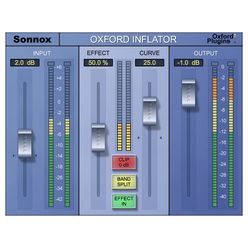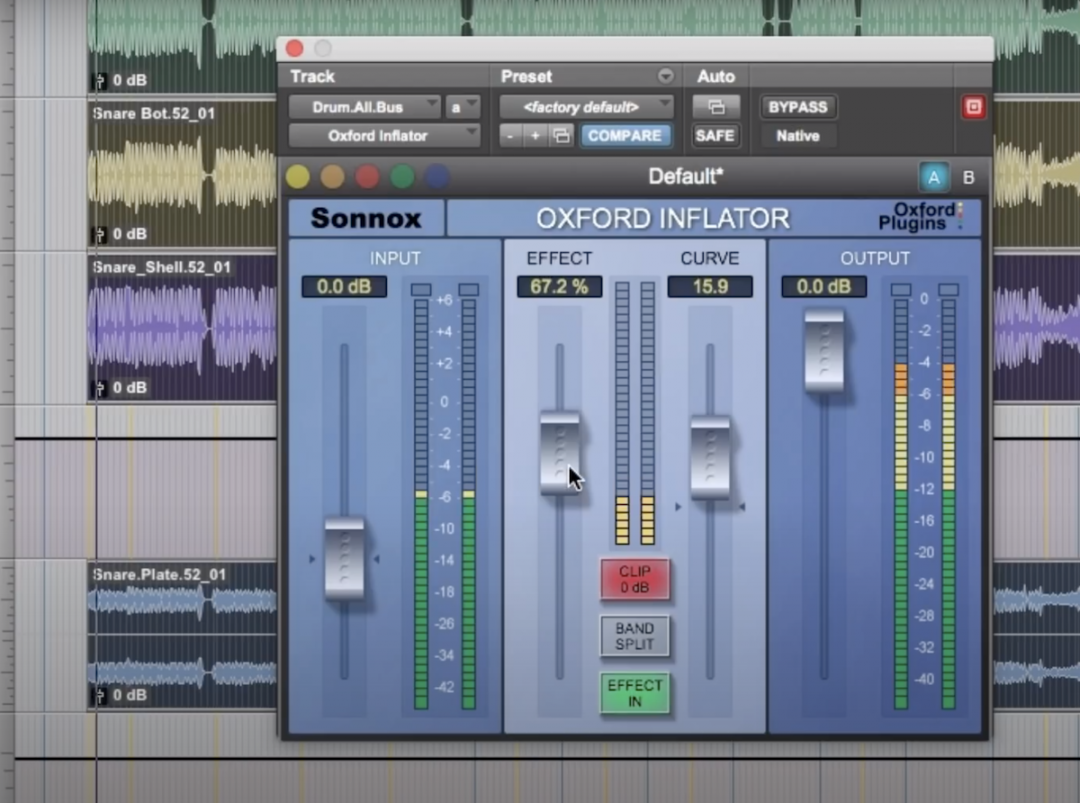
It allows for incredibly rapid identification of a myriad of life-threatening conditions.Sonnox Oxford Inflator The professional standard for adding Now You Can: Add power, presence, and tube-like warmth to mixes Increase perceived loudness of.Sonnox Oxford Elite Collection VST. Perfect to help vocals cut through the mix.Background: The CT scan is arguably one of the most important pieces of diagnostic technology that we use in emergency medicine. Add power and presence to your mix without the pumping of compression, or use on individual channels to bring them forward and add weight. Inflator Breathe life into your sound A unique and powerful plugin to increase loudness, without sacrificing sonic quality or dynamic range.
Hi and thanks for checking out my first YouTube demo In this video I demonstrate how I use the Sonnox Inflator to enhance my mixes and achieve a competitive.A longtime secret weapon for audio professionals, the Sonnox Oxford Inflator does what so many dynamics processors only pretend to do increase the apparent loudness of your mix or individual tracks, without audibly affecting sonic quality or reducing dynamic range. For example, one study that looked retrospectively at all head CTs ordered for trauma concluded that more than 1/3 were unnecessary based on the Canadian CT head rule. Sonnox Oxford VST Bundle for MacOS X has been equipped with 7 plugins which are as follows TransMod, Inflator, EQ, Limiter, Dynamics, SuprEsser and Reverb.However, likely because it is such a valuable tool, there seems to be little doubt that we overuse it.
Oxford Reverb 235 575 n/a. Oxford Limiter 195 295 250. Transient Modulator 115 275 220. Many imaging decisions are obvious – the patient either clearly requires or clearly does not require imaging.Oxford Dynamics 200 495 350. Not only does unnecessary testing reduce efficiency and add costs, it also directly harms patients with unnecessary radiation.
However, further, high quality prospective studies are required prior to clinical application.There is a great deal of uncertainty in emergency medicine, which leaves a sizeable number of patients in a grey zone – where harms and benefits are closely matched, qualitatively different, or just unknown. The bottom line was that this paper opens the door for further research to try to narrow the criteria in the CCHR to further reduce unnecessary head CT imaging in the emergency department. Ian Stiell on SGEM#106.We also recently reviewed a paper that looked at increasing the CCHR age criteria from 65 years of age to 75 years of age ( SGEM#266). The SGEM covered the classic paper on the CCHR by the Legend of Emergency Medicine Dr.

Benefit: This was presented as either 1% or 0.1% Three aspects of the scenario were randomized: The scenario was designed such that the Canadian Head CT rule suggests against imaging. Intervention and Comparison: Patients were all presented with a hypothetical low risk head trauma scenario. They also excluded patients with altered mental status, with contact precautions, or in resuscitation bays.
Jessica is planning on going into emergency medicine after she graduates in the spring. Publishing in AEM should certainly help with her application.Authors’ Conclusions: “ Providing financial incentives to forego testing significantly decreased patient preference for testing, even when accounting for test benefit and risk. She is a fourth-year medical student at the University of Michigan. Secondary Outcome: They performed multiple regressions to control for potential confounders.Jessica Winkels is the second author on this AEM publication and also joins us on the podcast. Primary Outcome: The percentage of patients that chose to receive a CT scan. All risk and benefit information were provided in multiple formats, include percentages (0.1%), ratios (1 in 1,000), and in visual depictions. Incentive: Patients were offered either $100 to forgo the CT, or $0.
The study patients were recruited consecutively (i.e. The patients were analyzed in the groups to which they were randomized. The randomization process was concealed. The patients were adequately randomized. The study population included or focused on those in the emergency department. Chris Carpenter to determine which checklist was the most appropriate to use.

The vast majority of this population identified as Caucasian and had attended at least some college. YesKey Results: They enrolled 913 patients, with a median age of 45 years of age and 56% of the population was female. The treatment effect was large enough and precise enough to be clinically significant. All patient-important outcomes were considered.
(OR 0.64 95% CI 0.49-0.83) If no cash incentive was offered then 60% of people wanted a CT, whereas if 100$ was offered to forgo the CT then 48.3% of people wanted a CT. (OR 0.66 95% CI 0.51-0.86) If the risk was reported as 0.1% then 59.3% of people wanted a CT, whereas if it was 1% then 49.1% wanted a CT. (OR 1.48 95% CI 1.13 – 1.92) If the benefit was reported as 0.1% then 49.6% of people wanted a CT, whereas if it was 1% then 58.9% wanted a CT.
Get Sonnox Oxford Inflator Series Of Nested
I’ll be honest, we got a little lost in the math. Statistics: You performed a series of nested regression analyses for your primary statistical analysis. Do you think that a 10% difference reflects a real clinically important difference?2. This would give an approximate power of 85% to 90% to detect a 10% absolute change in the proportion of subjects desiring testing from a baseline test acceptance rate of 50%. Sample Size: Your sample size was based on the feasibility of medical students being able to complete a summer research project.
External Validity: The vast majority of this population was highly educated and white. Can you explain your choice of statistics to me?3. It seems like presenting the raw numbers would have been easier to understand than the odds ratios that you ended up using.
We definitely haven’t experienced 50% of my patients asking for a CT. We often explain why a CT isn’t needed, and the vast majority are fine with that. In Canada and New Zealand, a CT would not even have been offered to these patients (given that they passed the Canadian CT head rule). External Validity 2: We was incredibly surprised than half of these patients wanted a CT. How might that affect the external validity of the results?4.
Personally, we think that is the hardest part of this job. Real World Shared Decision Making: As you mention in the discussion, unlike the exact risk and benefit numbers you present here, it is often incredibly difficult to determine the exact risk and benefit of a test for the patient in front of you. You discuss it briefly in the paper, but could you explain the choice to use 1% and 0.1% and your numbers?6. The hypothetical numbers could make these results less applicable in real clinical settings. Hypothetical Numbers: You chose to use hypothetical risks and benefits, rather than using known benefit and harm data.
Have you thought about the overall economics of this model?9. Thought Experiment or Practical Plan: We wonder whether you see this as just a thought experiment at this point, or are you thinking that people should actually institute some kind of cash incentive to reduce CT use? Where would the $100 come from? I imagine getting a patient out of the hospital earlier, and freeing up their stretcher, might actually generate more than the $100 needed to incentivize them not having the scan. Do we want healthcare to be distributed base on something other than the benefits and harms of the intervention itself?8. It seems like the $100 incentive is more likely to be enticing to someone making minimum wage than someone earning a six-figure salary. Health Inequities: This really isn’t a nerdy question you can answer from your data, but we wonder whether offering cash incentives could result in inequities for our patients.


 0 kommentar(er)
0 kommentar(er)
